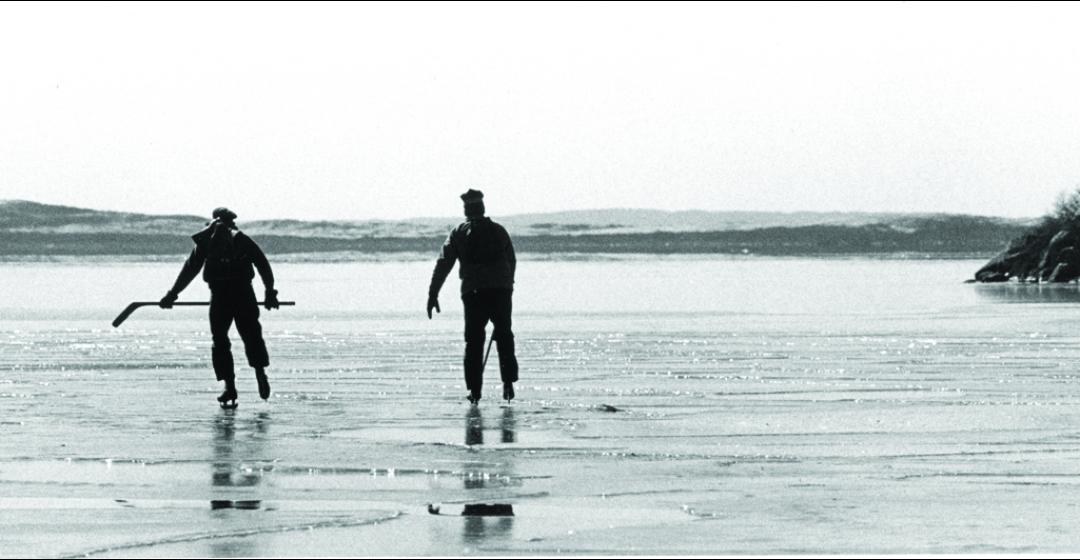For five days the wind had been light, and the ocean that had been raging against the cliff of Chilmark for much of January was now silent. The sun was washing the Island with great warmth, shining through a transparent sky. Although the temperature in the shade was at thirteen degrees, the feeling we got out on Squibnocket Pond at eleven in the morning was one of spring, an uncommon day for the month of February.
It had been very cold – cold enough to freeze the Great Ponds to maybe seven or eight inches – yet the cold had been accompanied by the clearest of weather. And because the wind had died at the time it became cold, the ice, as it froze, froze without ripples. For the first time in our memory the ice on the ponds that stretch down the edge of the Atlantic was almost uniformly clean and smooth. Luckily it had frozen when there was no wind to sweep across the barrier beaches and make a washboard of the water’s frozen surface. And if there was ever a time to skate the south shore of Martha’s Vineyard, this was it.
And so it was that when I asked Nat Benjamin to run the ponds with me he was immediately receptive. For a man who had skippered boats across the Atlantic three times, the idea of zooming down the ocean’s edge on ice, under a burning sun, held a certain appeal. Armed with hockey sticks, we arrived at Squibnocket Pond. The pond was devoid of people. We would be out there alone.
With a let’s go motion of his hand, Nat skated out to the middle of the pond, circling about like some aberrant Dick Button. Indeed, he seemed intoxicated by the beauty and the freedom of it all, and I sensed at once that caution was not to be our watchword, that freedom was to be our guide.
From the top of the pond we turned east and began our journey which would take us from Gay Head to the Herring Creek at Katama. Surely Squibnocket was a most inspiring place to start. The huge dunes that fronted the old Hornblower farm seemed Arabian under the bright sun. They rise high up into the pale blue sky, and the sun, which was a brilliant and fuzzy yellow, was positioned directly above them. You could imagine some elegant Kafir riding over the crest of the dunes, with white robes flowing behind him, his mount pulsing from the climb, his arms raised to inspire a veritable nation of mounted Moslem tribesmen. And you on your skates, a Hermes on ice, racing on and on.
There is bliss out in the middle, and once you have found it you stay there as long as you can even though large openings in the ice appear, seemingly at random in the great expanse. A pair of swans lift from one of the iceless patches. The speed of skating makes you feel that you too are flying as you watch the big birds, their slow undulating wings giving a rhythm to the moment. Whatever it is that is going on, you are a part of it.
The skating was wide open, and both of us skated at will, feeling the joy of abandonment. And so we began to click them off: Black Point Pond, Tisbury Great Pond. Long Cove and then Homer’s Pond, where we had our first encounter of the third kind – a figure rounding a bend on the ice and heading right for us. At first glance it was a bluish outline of some swift humanoid angling down on us, coming, as it were, out of nowhere, only yards from the Atlantic on ice as remote from civilization as Big Foot country. An abominable iceman, we thought, a dashing descendent from the icy lagoons of Saturn. As it neared we saw who it was, none other than the grand patron of Homer’s Pond, Arthur T. Hadley himself.
Stylish in one of those blue jackets that sailors wear, which are simultaneously windbreakers and life preservers, he seemed like a man in a painting. Out there in the middle of nowhere, thirty yards from the Atlantic coasting along, he was a country gentleman, some skating squire perambulating his boundaries, a fluid figure on glass. And glass it was. At times it was pellucid and you could look below your skates and see the scrubby bottom. It was dark and smooth as satin.
We skated across Watcha Pond and Oyster Pond and Job’s Neck. We had seen flocks of geese, some swans, and many herring gulls, and for a few moments we played hockey with a bitters bottle that we found resting quite inexplicably on the ice. But essentially we were not watching things. We were feeling the radiance of a brilliant winter day and the sense of freedom that comes when you skate with nature. We felt exultant, euphoric, and free as the wind that finally began to pick up about the time we were setting off across the last great pond for Herring Creek.
And Nat Benjamin? He says he will try it again. Of course nature will have its say. But given another four or five days of very cold weather with no snow and no wind, Nat will give it a go. He thinks that with proper planning he can follow the ice way inland, up into areas of the Vineyard hitherto unseen by mortal man, and at the very least on skates he will see more of the Island than would ever see by car or by foot. And you know, he is probably right. u
Other than a ride between Squibnocket and Upper Chilmark Ponds, the pair skated or walked from Aquinnah to Katama. A version of this essay originally appeared in the Vineyard Gazette in 1978.





